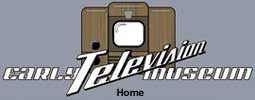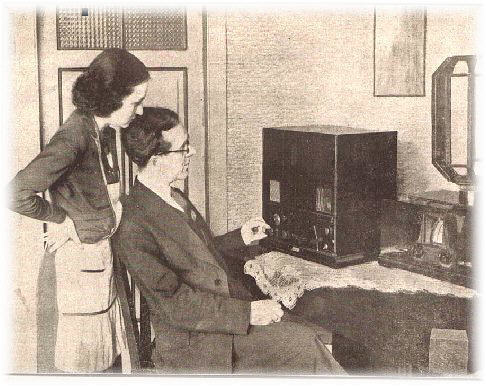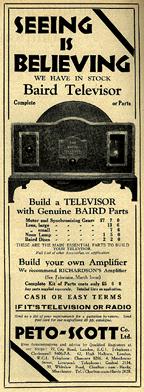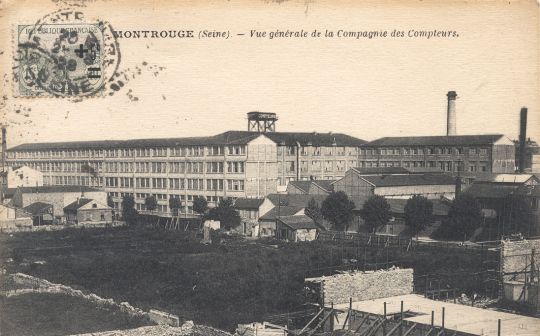 |
 |
Part One

Television at Home around 1932 (From the book 'Television' by C.Van DYCK).
Full installation with the world wide receiver for shorts and medium waves (Ingelen U6)
 |
 |
Part One

Television at Home around 1932 (From the book 'Television' by C.Van DYCK).
Full installation with the world wide receiver for shorts and medium waves (Ingelen U6)
Radio and television histories are closely linked together. In fact, television could have not existed without the development of key radio components, like radio tubes and efficients RF amplifiers. The french pionneers are, for the radio, General FERRIE and for television, René BARTHELEMY
Video clip from Discovery Channel about beginnings of television and early pionneers.
Nowadays, television experiences continuous and fast technological changes. The cathodic era is replaced from now on, by LCD or plasma technology and some others coming.
The actual Television is the result of a long history which reflect the contribution of many people in several countries. As far as France is concerned, the Television get really widely deveilled to the public only after World War II.

Some American manufacturers like RCA, followed BAIRD in his marketing action and produced a few thousands of
mechanical television sets for their own market. in 1928.
In 1927,Charles Francis JENKINS,
worked on his 'Radiovisor' (mechanical transmission and reception of black and white steady images).
Nowadays, it remains very little specimens of those early sets.
Scientists in the USA, such as Philo T. FARNSWORTH with its 'Image Dissector' and
Vladimir ZWORYKIN , with its 'Iconoscope', contributed to important progresses in the field of the electronic television cameras.
For more information on the history of these early television pioneers, see the links to excellent web sites (in English) at the bottom of our MENU.
In France, in 1928, the 'Compagnie des Compteurs de Montrouge' (C.D.C.), hired a high skilled mathematician, René BARTHELEMY for developping the company's very first laboratory research dedicated to television.

Graduated from the Electricity High School (SUPELEC), BARTHELEMY studied the John L.BAIRD experiments on mechanical television, as soon as he joined the CDC. He then invested himself in the research for an effective system of synchronization, without which a television system cannot function correctly.
The experiments of BAIRD and BARTHELEMY and their results, strongly influenced other french scientists to invest in television, among those, where
Marc CHAUVIERRE in Lyon, Henri De FRANCE and CAHEN in Le Mans and TURPAIN and BODROUX in Poitier. All started their own experiments with mechanical television by 1930.

In France, early Television was also known as Radiovision. Its used a mechanical system for the analysis and the synthesis of the image, from where cames the name of 'Mechanical' Television. Since many years (from end 1936), these operations are carried out in an entirely electronic way.
Principles of mechanical analysis and synthesis of the image with the Nipkow scanning disc .
In 1884, a young German student born in the Pomerania county, Paul Julius NIPKOW, invents the disc which bears its name. This is about a brilliant invention making it possible to break up and rebuild an image by means of a non-transparent disc, in which tiny holes are punched among a spiral, close to the circumference of the disc. It is interesting to note that Paul NIPKOW having found the scanning method, will not be able himself to use it, because in 1884, the radio tube allowing transmission and amplification of a radio signal is not invented yet nor the photocells allowing the translation of the light into an electric current!
Without our physiological faculty of retinal persistency, which makes possible for our brain to memorizes a luminous impression during approximately a tenth of a second, television could not exist (nor the cinema ).
It is our retinal persistency which makes us able to see these famous lines in television, lines which in fact does not exist really. They are only a visual effect produced by a luminous spot moving quickly in front of our eyes.
All the techniques used in television, mechanics, cathodic then plasma or LCD, works based on this phenomenon.
With the Nipkow disc system, the number of lines which reproduces an image correspond exactly with the number of holes composing the spiral. That is, 30 holes = 30 lines, 60 holes = 60 lines etc. For mechanical reasons, it appear that the limits of the system are reached for a definition of 120 or 180 lines (with 3 spirals). Effectively, the diameter of the disc grows proportionally with the number of holes and that makes the disc diameter quickly to reach prohibitory dimensions, incompatible with an efficient synchronization of the system. During a transmission, the holes in the analyzing disc, explore sequencially each point of the image through a window placed near the disc surface. The window dimensions are related to the number of holes and their diameter. For having the system to function properly, it is mandatory that only one hole at a time can be seen through the windows.
Behind the analyzer disc, is a photocell which transforms the variations of light coming from the 'active' hole passing through the window, into electric pulses (very weak). The holes of the receiving scanning disc rebuild the image thanks to a neon lamp placed behind the disc . The orange light issued from the neon lamp, passes through the holes and the window, and its rapid intensity variations reflects the electric impulses issued from the photocell.
The analyzer and receiving discs must be rigorously synchronized. Not only their speed must be absolutely identical, but their holes must reflect the same spatial position in respect to the window to provide a correct framing of the image.
That explain the sort of problems that the early experimeters had to deal with, to obtain satisfactory results with the discs. Despite these mechanical difficulties, overcomed partly with the use of synchronous motors or phonic wheels, the early television systems widely used the Nipkow scanning disc and several variants (BRILLOUIN's lens disk) to analyze and reconstruct television images.